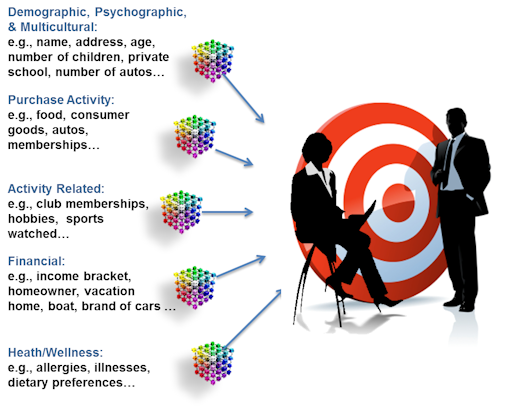The business world has changed dramatically over the past few decades. Terms like big data, omnichannel operations, digital marketing, targeted marketing, personas, and others are scattered all over the business landscape. Business leaders are told big data is the new oil; but, they must also acknowledge that data breaches can make data a liability. Marketers and retailers are told personalization is the future; but, they must also acknowledge that personalization can cross the “creepy line” and can hurt their company’s reputation. Fretty Francis, a Content Marketing Specialist at SoftwareSuggest, writes, “If you own and run a business, your primary responsibility is to create and retain customers. Now, in order to keep your buyers to keep coming back, you need to cultivate a relationship, based on trust and loyalty.”[1] In other words, you need to get to know your customers. Data can help you achieve that goal. But you must also gain their trust by protecting the data they provide.
Getting to know your customers
Nancy Marshall (@maineprmaven), CEO and Founder of Marshall Communications, writes, “One key component of any marketing program is determining a target audience. That is, once you’ve developed a message, who do you want consuming it?”[2] She cautions, however, “You are not the target audience.” She suggests several questions to ask: “Who should care? And who will care? How am I going to create compelling content that attracts the people my business can best serve?” She adds, “It may seem like common sense, but your target audience is just as important as the message itself, and the channels by which you’re communicating it. Picking the right audience can turn an otherwise average PR campaign into a resounding success. Choosing the wrong audience, however, can derail even the best-laid talking points. Targeting the right demographic can be invaluable.”
Francis agrees with Marshall about the disastrous effects of choosing the wrong target audience. She writes, “[If] they are not relevant to the services and products offered by your company, … no amount of strategies will be enough to generate profits. Hence, the first step is to zero-in on the ideal customer base. How do you do that? By creating targeted customer profiles.” Depending on your business, target customer profiles (aka personas) can be clients, companies, buyers, or some combination of those groups. Creating good customer personas requires good data and good analytics. Francis notes, “Creating, storing, and using the data from customer profiles is very important to further the growth of your business. … When you create a buyer persona, you can extract the exact, relevant attributes from the database. … You can use this information to find more leads that showcase similar traits. This is a much better option than running generic marketing campaigns or putting up advertisements, without even knowing who might be your actual profit-generating customer.”
The reason analyzing data is so important is because people are different. Marketers often talk about generations (e.g., baby boomers and millennials), knowing full well members of generations can have wildly different life and buying preferences. Marshall writes, “The United States is home to more than 300 million people of different ages, colors and creeds. We truly live in a melting pot. Also, just because someone is female, 40 years old and likes shopping does not mean that she is the same as another person the same age. One 40-year-old might like shopping at Cabela’s for hunting supplies, and the other might like going to the makeup counter at Nordstrom. So it’s important to drill down and know your audience. I sometimes say that marketing is like marriage. You need to know your partner so well that you can anticipate their every move and preference.” Good data and advanced analytics can generate that kind of granularity. Today, business leaders are turning to cognitive technologies for many business activities, including generating customer personas. As an example, the Enterra Shopper Marketing and Consumer Insights Intelligence System™, powered by the Enterra Cognitive Core™, can leverage all types of consumer data to provide high-dimensional consumer, retailer, and marketing insights.
Beyond personas
Some marketers worry legislation dealing with consumer privacy concerns will curtail their ability to develop and leverage customer personas. Although I agree that could be a problem, I believe enough data will be available to help companies understand their customers. Nevertheless, some experts recommend looking at targeting customers a different way — understanding what they want rather than who they are. The Forbes Business Development Council notes, “Before you develop a new product or service, you need to have a target audience in mind. Identifying your primary consumers will help you better market your offerings and connect with your buyers.”[3] Joe Hipsky, CSO at iraLogix, states, “‘Build it and they will come’ rarely works. If you’re tuned in, the market will tell you what to sell it. If a client makes a request, it’s just that — a request. If it’s three or more, its something to pay attention to. If it’s ten-plus, it’s a thing. Work with those close clients to create the solution with a mind toward those clients and prospects who are just like them.”[4]
Denise Lee Yohn (@deniseleeyohn), a brand leadership expert, believes the late Clay Christensen had the right idea when he argued in favor of the Jobs to be done (JTBD) theory. Yohn notes, “Jobs to be done is a framework for understanding customers and their motivations for adopting a new product or service. … Conventional thinking on developing and marketing innovations, Christensen observed, focuses on knowing more and more about customers, which may or may not lead to productive insights about the products they actually would be interested in. JTBD instead builds on Theodore Levitt’s insight, ‘People don’t want to buy a quarter-inch drill. They want a quarter-inch hole!’ — and provides a more reliable path to new product success by seeking to understand what the customer is trying to do.”[5] The JTBD framework doesn’t rely as heavily on personal data, but it nevertheless relies on data and advanced analytics to succeed.
Concluding thoughts
Francis concludes, “If you wish to see your business grow, you need to invest time and resources on creating the ideal, targeted customer profiles. This database is a goldmine for your company, especially for the sales and marketing departments. The more insights you have about your customers, the more you can gather high-quality leads who shall be instrumental in generating profits in the present as well as the future.” Yohn cautions, “Personas may provide a rich understanding of what someone is doing today, but they don’t reveal what trade-offs or work-arounds they are accepting because there is no alternative — nor what that person really wants to do and the value of accomplishing it. … Given the nearly universal access and proliferation of choices available to customers today, the JTBD theory of innovation makes sense now more than ever.” At least in the near-term, a combination of personas and JTBD theory is probably the best way forward for most businesses.
Footnotes
[1] Fretty Francis, “Tips to Create Customer Profiles to Target Qualified Leads,” Customer Think, 28 August 2019.
[2] Nancy Marshall, “Remember: You Are Not The Target Audience,” Forbes, 11 October 2019.
[3] Forbes Business Development Council, “Six Ways To Identify And Target The Ideal Audience For Your New Product,” Forbes, 15 February 2019.
[4] Ibid.
[5] Denise Lee Yohn, “Clay Christensen’s Jobs To Be Done Innovation Theory Challenges Common Innovation And Marketing Methods,” Forbes, 4 February 2020.





